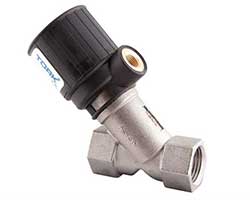
24 Apr Angle valve
An angle valve, also known as a corner valve or angle stop valve, is a type of plumbing valve used to control the flow of water or other fluids in a pipeline. It is designed to be installed at a 90-degree angle to the pipeline, hence the name “angle valve.”
Angle valves typically consist of a body with an inlet and an outlet, a handle or lever for manual operation, and a sealing mechanism to control the flow. The sealing mechanism can be a rubber washer, a ball, or a disk, depending on the specific design of the valve.
The main purpose of an angle valve is to regulate or shut off the flow of fluid in a plumbing system. They are commonly used in residential and commercial applications, such as sinks, toilets, faucets, water heaters, and appliances that require a water supply.
Some common features and applications of angle valves include:
Water Supply Control: Angle valves are commonly used to control the water supply to plumbing fixtures. They allow users to turn the water on or off, adjust the flow rate, or shut off the water supply in case of emergencies or repairs.
Accessibility and Installation: Angle valves are typically installed at the point where the water supply line connects to the fixture. The 90-degree angle design makes them easily accessible and allows for convenient operation and maintenance.
Variations in Design: Angle valves come in different sizes, materials, and configurations to accommodate various pipe sizes, pressure ratings, and specific plumbing requirements. They can be made from materials such as brass, bronze, or plastic, depending on the application and the type of fluid being controlled.
Compression or Threaded Connections: Angle valves are available with different connection types, including compression fittings or threaded connections. Compression fittings use a nut and ferrule to create a watertight seal, while threaded connections require the use of pipe threads and sealants.
Emergency Shut-off: Angle valves are often used as emergency shut-off valves in plumbing systems. In case of a leak or plumbing failure, turning off the angle valve can quickly stop the flow of water to prevent further damage.
It’s important to note that angle valves should be operated carefully to avoid overtightening or forcing the valve, as it can cause damage to the sealing mechanism. Proper installation and maintenance are essential to ensure the longevity and proper functioning of angle valves.
